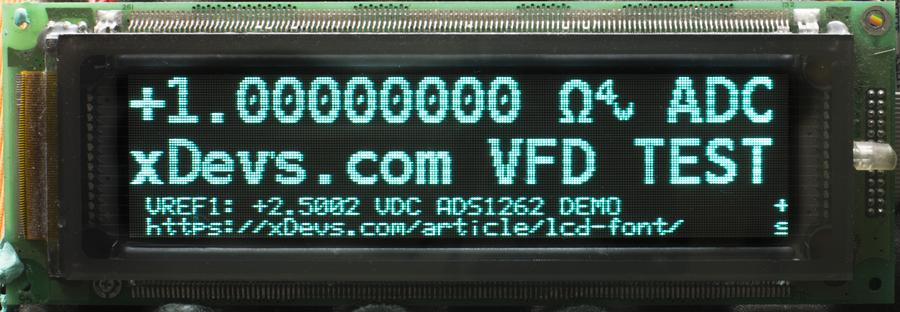24×14 pixel ASCII font
This font can be easily used on graphics LCDs with horizontal size over 64 pixel. It have bold, clearly readable bold letters. Typical 160×32 pixel LCD can display up to 11 characters in single line, having still one line for standard 8×6 pixel font.
Bitmap is created and tweaked in graphics editor, using 24pt DejaVu Sans Monospace font as a base.

Font was generated in single 1485×24 pixel bitmap, rotated 90° CCW, inverted and saved as WBMP-file
Using WinHEX, C-code variable values dump was generated for simple library in C:
Source code file, C language with font bitmap
Source code file, C language header
**
* Font table for 24x14 pixel characters
*/
#include "font_2414.h"
const unsigned char font_2414_b[4455] = {
0x00, 0x00, 0x00, 0x00, 0x00, 0x00, 0x00, 0x00, 0x00, 0x00, 0x00, 0x00, 0x00, 0x00, 0x00, 0x00,
0x00, 0x00, 0x00, 0x00, 0x00, 0x00, 0x00, 0x00, 0x00, 0x00, 0x00, 0x00, 0x00, 0x00, 0x00, 0x00,
0x00, 0x00, 0x00, 0x00, 0x00, 0x00, 0x00, 0x00, 0x00, 0x00, 0x00, 0x00, 0x00, 0x00, 0x00, 0x00,
...
...
0x0E, 0x0C, 0x06, 0x04, 0x0C, 0x06, 0x00, 0x0C, 0x06, 0x00, 0x0C, 0x06, 0x00, 0x00, 0x00, 0x00,
0x00, 0x00, 0x00, 0x00, 0x00, 0x00, 0x00
};
This font can be used by simple function, such as:
void draw_char_2414(uint8_t id, uint8_t x) {
uint16_t i;
id = id - 32; // Bitmap don't have first 32 symbols, so we skip their ID.
lcd_set_line(0, COL0 + x*FONT_2414_HZ); // Draw first line (top 8 bits)
for (i = id*FONT_2414_HZ ; i < FONT_2414_HZ*id+FONT_2414_HZ; i++) {
lcd_draw( font_2414_b[i*3+2] );
}
lcd_set_line(1, COL0 + x*FONT_2414_HZ); // Draw second line (middle 8 bits)
for (i = id*FONT_2414_HZ ; i < FONT_2414_HZ*id+FONT_2414_HZ ; i++) {
lcd_draw( font_2414_b[i*3+1] );
}
lcd_set_line(2, COL0 + x*FONT_2414_HZ); // Draw third line (bottom 8 bits)
for (i = id*FONT_2414_HZ ; i < FONT_2414_HZ*id+FONT_2414_HZ ; i++) {
lcd_draw( font_2414_b[i*3] );
}
}
Example output on negative LCD screen can look like this:
Wrap function such as below can be used to take input string and output char’s:
void lcd_print_big(char* str, uint8_t x) {
uint8_t ch, i;
uint8_t xcnt = x;
while (*str != 0) {
ch = *str;
draw_char_2414(ch, xcnt);
xcnt++;
str++;
}
}
It’s used in example below:
sprintf(string,"%2.5f \x81\x7F", val); sprintf(strx,"24x16 font test"); lcd_print_big((uint8_t *)string, 0); lcd_print((uint8_t *)strx, 0, 3);
LCD photo:

VFD photo (256×64 graphics):
This font also have special characters:
| Char position number | Symbol |
| 128 (/x7E) | ~ |
| 129 (/x7F) | 4W symbol |
| 130 (/x80) | ° |
| 131 (/x81) | Ω |
| 132 (/x82) | √ |
| 133 (/x83) | α |
| 134 (/x84) | β |
| 135 (/x85) | ≠ |
| 136 (/x86) | ½ |
| 137 (/x87) | ¾ |
| 138 (/x88) | Σ |
Also for mirrored addressing here are vertically flipped bitmap and Source code file
SEP.2022 Update:
Tom Collins reused and slightly modified bitmap above for his LCD application. His GitHub repostory also included additional Python script used to convert the .bmp file to a .fnt file for use by 4D Systems’s Workshop4 IDE.
Projects like this are born from passion and a desire to share how things work. Education is the foundation of a healthy society - especially important in today's volatile world. xDevs began as a personal project notepad in Kherson, Ukraine back in 2008 and has grown with support of passionate readers just like you. There are no (and never will be) any ads, sponsors or shareholders behind xDevs.com, just a commitment to inspire and help learning. If you are in a position to help others like us, please consider supporting xDevs.com’s home-country Ukraine in its defense of freedom to speak, freedom to live in peace and freedom to choose their way. You can use official site to support Ukraine – United24 or Help99. Every cent counts.
Modified: Sept. 8, 2022, 12:45 a.m.

